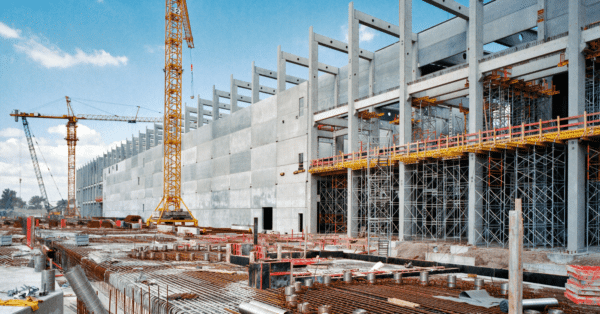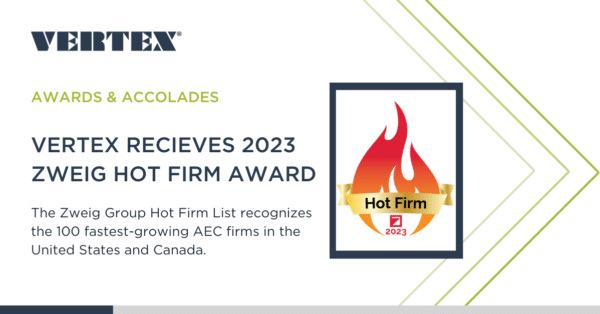In 2016, I had the honor of representing Xpera Group (now part of VERTEX) at Zweig Group’s annual Hot Firms conference, which celebrates the top architecture, engineering, and construction consulting firms in the country. In her opening keynote address, Zweig’s director of research, Christina Zweig Niehues, implored attendees to “unlock the hidden data” that our collective firms hold.
According to Niehues, less than 0.5% of the data that most companies in design and construction have produced ever gets analyzed. In other words, there is a mountain of untapped resources tucked away on various servers that could be leveraged to offer incredible value to clients, the firm itself, and for the benefit of our peers.
“There’s Gold in Them Thar Hills…”
In the tech industry today, there is much discussion over the topic of “Big Data”—the analysis of extremely large data sets to identify trends, patterns, and various associations. In the construction industry, particularly for those of us with extensive backgrounds in forensics, analyzing large data sets to derive some understanding is nothing new. In fact, here are a few examples of how some of my colleagues and I have leveraged data analysis on past projects:
- An analysis of quality assurance data allowed us to help some of our builder clients understand which trades, and which trade contractors, contributed the most to issues requiring correction.
- In the absence of a properly updated schedule, we used daily reports produced by a project’s Inspector of Record (IOR) to defend our trade contractor client from a delay claim.
- Advanced electronic cataloging and searching of a 40+ gigabyte job file allowed us to uncover more than 1,000 owner-initiated changes on a project that were otherwise undocumented.
- By comparing building permit filings with court filings, we were able to predict a decrease in construction litigation in 2012 and the subsequent increase we are now seeing.
The Construction Digital Revolution
The first digital revolution to impact the design and construction industry began not so much with the widespread availability of the personal computer, but with the adoption of some very important applications that we tend to take for granted. CAD software introduced a level of precision not available before that also opened the door to electronic take-offs, which in turn led to the rapid development of cost systems. Electronically produced schedules that could be easily updated were an important innovation.
But the “killer app” responsible for bringing most design and construction firms into the modern world was email. By the turn of the century, email became the de facto standard for documenting and communicating project information.
Mobile computing devices represent the second digital revolution for our industry. Now that nearly every single person involved in a construction project carries one on them at all times, it isn’t hard to understand precisely where all this data comes from.
What this means is that during the course of a construction project, instead of reams of paper artifacts documenting the various goings-on, we now rely on the data stored across the various computer systems, hard drives, servers, cloud repositories, and elsewhere in the ether.
The key—and this is truly one of the biggest challenges our industry faces right now—is how do we extract important and valuable information from the data?
One huge problem that comes from such large collections of data is that no single human being can possibly retain and catalog all of the information. The only way to extract meaningful information from massive data sets (such as what we find on a typical large construction project) is with the assistance of digital tools.
There are three things required to get results when analyzing massive data sets:
- The Right Tools
- The Right Process
- The Right People
We’re Going to Need a Bigger Toolbox
Fortunately, the design and construction industry is not the first industry, nor is it the last, to deal with the problems and challenges of information overload.
The legal industry, especially in such areas as intellectual property and financial fraud, has made use of advanced data analytics software for years. So-called “e-discovery” software makes it possible to leverage computational power to search and catalog the proverbial needles hidden throughout the various haystacks.
How the Sausage is Made
The process of extracting useful information from a massive collection of digital data depends on what questions you’re ultimately trying to answer.
The first step in the process is to define your criteria for what exactly it is you are looking for. If you don’t ask the right questions, I can almost guarantee that you won’t find the right answers.
Before you can perform any analysis, however, there needs to be something to analyze. Sometimes, especially on forensic assignments, our data comes to us in the form of scanned documents. In other words, it is a picture of a document. For the computer(s) to be able to work with that data, it is essential to use Optical Character Recognition (OCR) to turn the pictures into words and numbers.
The next step is to create a catalog of all the words and numbers contained within the data set. By comparison, Google scans billions of websites daily, cataloging that information in order to return relevant search results to us.
With the information cataloged, the analysis process can then be used to extract meaning and value from the data using sophisticated and specialized tools. We review the results of our efforts and make adjustments along the way.
Experience is Always the Best Solution
The art of the data analysis process is knowing what to search for in order to achieve the stated objective. This is where experience comes into play.
The biggest challenge people face with Big Data is finding someone with the right background. You’re not going to find a college degree program, or even a single college course, that can teach you how to make sense out of construction data.
It takes someone with a strong background in construction standards of practice, combined with a strong background in information technology, especially in database administration. Plus, there is no substitute for solid research skills.
In short, the process requires someone who is both a “digital native” and a construction industry veteran. That’s a rare commodity. In my own case, I’ve been immersed in technology for most of my life, and have in fact advised and been a part of several software companies. Additionally, over the last two decades, I’ve produced tens of thousands of billable hours performing forensic analysis on more than a thousand projects. This unique background serves me well when it comes to using Big Data to solve construction challenges.
What Can You Learn from Your Data?
There are all sorts of valuable applications for Big Data analysis in our industry that remain largely untapped. Just a few examples include analyzing billings to evaluate which segments of your business produce the most revenue, identifying potential risk factors that have gone unnoticed, or assessing the remaining useful life of key building systems across an entire portfolio. You never know where the hidden “gold” can be found until you start digging.
If you are interested in learning more or seeing some examples of how we’ve leveraged the Big Data locked away in projects for our clients, and the industry at large, contact Brian Hill.
This article was originally published by Xpera Group which is now part of The Vertex Companies, LLC.








